Griffith School of Engineering and Built Environment.
VerifiedAdded on 2022/11/11
|10
|3738
|79
AI Summary
i need research proposal related to my engineering in civil engineering field. please follow all the attachaments what i submitted. if you are not follow the guidlines i will be awarded as zero
Contribute Materials
Your contribution can guide someone’s learning journey. Share your
documents today.
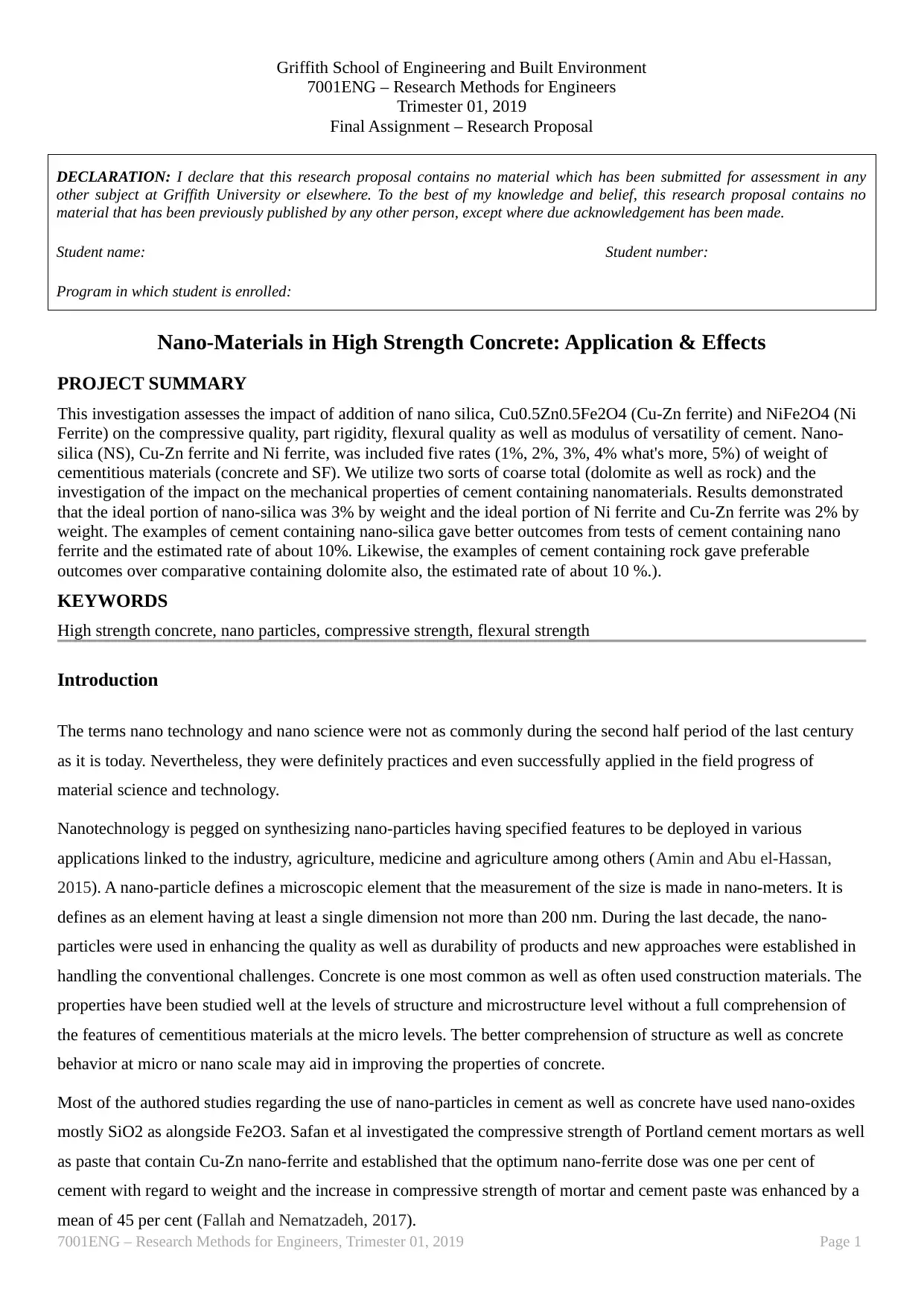
Griffith School of Engineering and Built Environment
7001ENG – Research Methods for Engineers
Trimester 01, 2019
Final Assignment – Research Proposal
DECLARATION: I declare that this research proposal contains no material which has been submitted for assessment in any
other subject at Griffith University or elsewhere. To the best of my knowledge and belief, this research proposal contains no
material that has been previously published by any other person, except where due acknowledgement has been made.
Student name: Student number:
Program in which student is enrolled:
Nano-Materials in High Strength Concrete: Application & Effects
PROJECT SUMMARY
This investigation assesses the impact of addition of nano silica, Cu0.5Zn0.5Fe2O4 (Cu-Zn ferrite) and NiFe2O4 (Ni
Ferrite) on the compressive quality, part rigidity, flexural quality as well as modulus of versatility of cement. Nano-
silica (NS), Cu-Zn ferrite and Ni ferrite, was included five rates (1%, 2%, 3%, 4% what's more, 5%) of weight of
cementitious materials (concrete and SF). We utilize two sorts of coarse total (dolomite as well as rock) and the
investigation of the impact on the mechanical properties of cement containing nanomaterials. Results demonstrated
that the ideal portion of nano-silica was 3% by weight and the ideal portion of Ni ferrite and Cu-Zn ferrite was 2% by
weight. The examples of cement containing nano-silica gave better outcomes from tests of cement containing nano
ferrite and the estimated rate of about 10%. Likewise, the examples of cement containing rock gave preferable
outcomes over comparative containing dolomite also, the estimated rate of about 10 %.).
KEYWORDS
High strength concrete, nano particles, compressive strength, flexural strength
Introduction
The terms nano technology and nano science were not as commonly during the second half period of the last century
as it is today. Nevertheless, they were definitely practices and even successfully applied in the field progress of
material science and technology.
Nanotechnology is pegged on synthesizing nano-particles having specified features to be deployed in various
applications linked to the industry, agriculture, medicine and agriculture among others (Amin and Abu el-Hassan,
2015). A nano-particle defines a microscopic element that the measurement of the size is made in nano-meters. It is
defines as an element having at least a single dimension not more than 200 nm. During the last decade, the nano-
particles were used in enhancing the quality as well as durability of products and new approaches were established in
handling the conventional challenges. Concrete is one most common as well as often used construction materials. The
properties have been studied well at the levels of structure and microstructure level without a full comprehension of
the features of cementitious materials at the micro levels. The better comprehension of structure as well as concrete
behavior at micro or nano scale may aid in improving the properties of concrete.
Most of the authored studies regarding the use of nano-particles in cement as well as concrete have used nano-oxides
mostly SiO2 as alongside Fe2O3. Safan et al investigated the compressive strength of Portland cement mortars as well
as paste that contain Cu-Zn nano-ferrite and established that the optimum nano-ferrite dose was one per cent of
cement with regard to weight and the increase in compressive strength of mortar and cement paste was enhanced by a
mean of 45 per cent (Fallah and Nematzadeh, 2017).
7001ENG – Research Methods for Engineers, Trimester 01, 2019 Page 1
7001ENG – Research Methods for Engineers
Trimester 01, 2019
Final Assignment – Research Proposal
DECLARATION: I declare that this research proposal contains no material which has been submitted for assessment in any
other subject at Griffith University or elsewhere. To the best of my knowledge and belief, this research proposal contains no
material that has been previously published by any other person, except where due acknowledgement has been made.
Student name: Student number:
Program in which student is enrolled:
Nano-Materials in High Strength Concrete: Application & Effects
PROJECT SUMMARY
This investigation assesses the impact of addition of nano silica, Cu0.5Zn0.5Fe2O4 (Cu-Zn ferrite) and NiFe2O4 (Ni
Ferrite) on the compressive quality, part rigidity, flexural quality as well as modulus of versatility of cement. Nano-
silica (NS), Cu-Zn ferrite and Ni ferrite, was included five rates (1%, 2%, 3%, 4% what's more, 5%) of weight of
cementitious materials (concrete and SF). We utilize two sorts of coarse total (dolomite as well as rock) and the
investigation of the impact on the mechanical properties of cement containing nanomaterials. Results demonstrated
that the ideal portion of nano-silica was 3% by weight and the ideal portion of Ni ferrite and Cu-Zn ferrite was 2% by
weight. The examples of cement containing nano-silica gave better outcomes from tests of cement containing nano
ferrite and the estimated rate of about 10%. Likewise, the examples of cement containing rock gave preferable
outcomes over comparative containing dolomite also, the estimated rate of about 10 %.).
KEYWORDS
High strength concrete, nano particles, compressive strength, flexural strength
Introduction
The terms nano technology and nano science were not as commonly during the second half period of the last century
as it is today. Nevertheless, they were definitely practices and even successfully applied in the field progress of
material science and technology.
Nanotechnology is pegged on synthesizing nano-particles having specified features to be deployed in various
applications linked to the industry, agriculture, medicine and agriculture among others (Amin and Abu el-Hassan,
2015). A nano-particle defines a microscopic element that the measurement of the size is made in nano-meters. It is
defines as an element having at least a single dimension not more than 200 nm. During the last decade, the nano-
particles were used in enhancing the quality as well as durability of products and new approaches were established in
handling the conventional challenges. Concrete is one most common as well as often used construction materials. The
properties have been studied well at the levels of structure and microstructure level without a full comprehension of
the features of cementitious materials at the micro levels. The better comprehension of structure as well as concrete
behavior at micro or nano scale may aid in improving the properties of concrete.
Most of the authored studies regarding the use of nano-particles in cement as well as concrete have used nano-oxides
mostly SiO2 as alongside Fe2O3. Safan et al investigated the compressive strength of Portland cement mortars as well
as paste that contain Cu-Zn nano-ferrite and established that the optimum nano-ferrite dose was one per cent of
cement with regard to weight and the increase in compressive strength of mortar and cement paste was enhanced by a
mean of 45 per cent (Fallah and Nematzadeh, 2017).
7001ENG – Research Methods for Engineers, Trimester 01, 2019 Page 1
Secure Best Marks with AI Grader
Need help grading? Try our AI Grader for instant feedback on your assignments.
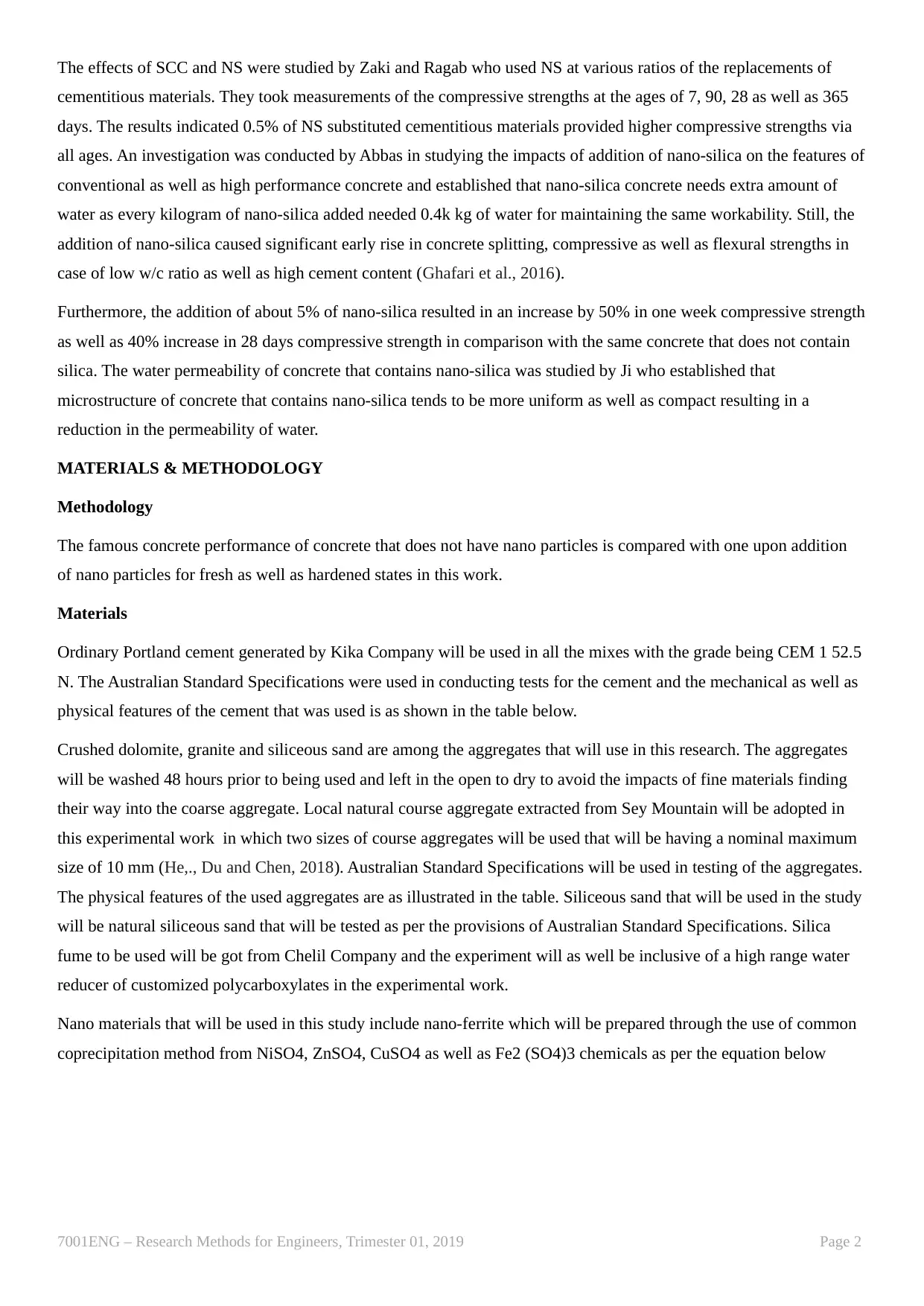
The effects of SCC and NS were studied by Zaki and Ragab who used NS at various ratios of the replacements of
cementitious materials. They took measurements of the compressive strengths at the ages of 7, 90, 28 as well as 365
days. The results indicated 0.5% of NS substituted cementitious materials provided higher compressive strengths via
all ages. An investigation was conducted by Abbas in studying the impacts of addition of nano-silica on the features of
conventional as well as high performance concrete and established that nano-silica concrete needs extra amount of
water as every kilogram of nano-silica added needed 0.4k kg of water for maintaining the same workability. Still, the
addition of nano-silica caused significant early rise in concrete splitting, compressive as well as flexural strengths in
case of low w/c ratio as well as high cement content (Ghafari et al., 2016).
Furthermore, the addition of about 5% of nano-silica resulted in an increase by 50% in one week compressive strength
as well as 40% increase in 28 days compressive strength in comparison with the same concrete that does not contain
silica. The water permeability of concrete that contains nano-silica was studied by Ji who established that
microstructure of concrete that contains nano-silica tends to be more uniform as well as compact resulting in a
reduction in the permeability of water.
MATERIALS & METHODOLOGY
Methodology
The famous concrete performance of concrete that does not have nano particles is compared with one upon addition
of nano particles for fresh as well as hardened states in this work.
Materials
Ordinary Portland cement generated by Kika Company will be used in all the mixes with the grade being CEM 1 52.5
N. The Australian Standard Specifications were used in conducting tests for the cement and the mechanical as well as
physical features of the cement that was used is as shown in the table below.
Crushed dolomite, granite and siliceous sand are among the aggregates that will use in this research. The aggregates
will be washed 48 hours prior to being used and left in the open to dry to avoid the impacts of fine materials finding
their way into the coarse aggregate. Local natural course aggregate extracted from Sey Mountain will be adopted in
this experimental work in which two sizes of course aggregates will be used that will be having a nominal maximum
size of 10 mm (He,., Du and Chen, 2018). Australian Standard Specifications will be used in testing of the aggregates.
The physical features of the used aggregates are as illustrated in the table. Siliceous sand that will be used in the study
will be natural siliceous sand that will be tested as per the provisions of Australian Standard Specifications. Silica
fume to be used will be got from Chelil Company and the experiment will as well be inclusive of a high range water
reducer of customized polycarboxylates in the experimental work.
Nano materials that will be used in this study include nano-ferrite which will be prepared through the use of common
coprecipitation method from NiSO4, ZnSO4, CuSO4 as well as Fe2 (SO4)3 chemicals as per the equation below
7001ENG – Research Methods for Engineers, Trimester 01, 2019 Page 2
cementitious materials. They took measurements of the compressive strengths at the ages of 7, 90, 28 as well as 365
days. The results indicated 0.5% of NS substituted cementitious materials provided higher compressive strengths via
all ages. An investigation was conducted by Abbas in studying the impacts of addition of nano-silica on the features of
conventional as well as high performance concrete and established that nano-silica concrete needs extra amount of
water as every kilogram of nano-silica added needed 0.4k kg of water for maintaining the same workability. Still, the
addition of nano-silica caused significant early rise in concrete splitting, compressive as well as flexural strengths in
case of low w/c ratio as well as high cement content (Ghafari et al., 2016).
Furthermore, the addition of about 5% of nano-silica resulted in an increase by 50% in one week compressive strength
as well as 40% increase in 28 days compressive strength in comparison with the same concrete that does not contain
silica. The water permeability of concrete that contains nano-silica was studied by Ji who established that
microstructure of concrete that contains nano-silica tends to be more uniform as well as compact resulting in a
reduction in the permeability of water.
MATERIALS & METHODOLOGY
Methodology
The famous concrete performance of concrete that does not have nano particles is compared with one upon addition
of nano particles for fresh as well as hardened states in this work.
Materials
Ordinary Portland cement generated by Kika Company will be used in all the mixes with the grade being CEM 1 52.5
N. The Australian Standard Specifications were used in conducting tests for the cement and the mechanical as well as
physical features of the cement that was used is as shown in the table below.
Crushed dolomite, granite and siliceous sand are among the aggregates that will use in this research. The aggregates
will be washed 48 hours prior to being used and left in the open to dry to avoid the impacts of fine materials finding
their way into the coarse aggregate. Local natural course aggregate extracted from Sey Mountain will be adopted in
this experimental work in which two sizes of course aggregates will be used that will be having a nominal maximum
size of 10 mm (He,., Du and Chen, 2018). Australian Standard Specifications will be used in testing of the aggregates.
The physical features of the used aggregates are as illustrated in the table. Siliceous sand that will be used in the study
will be natural siliceous sand that will be tested as per the provisions of Australian Standard Specifications. Silica
fume to be used will be got from Chelil Company and the experiment will as well be inclusive of a high range water
reducer of customized polycarboxylates in the experimental work.
Nano materials that will be used in this study include nano-ferrite which will be prepared through the use of common
coprecipitation method from NiSO4, ZnSO4, CuSO4 as well as Fe2 (SO4)3 chemicals as per the equation below
7001ENG – Research Methods for Engineers, Trimester 01, 2019 Page 2
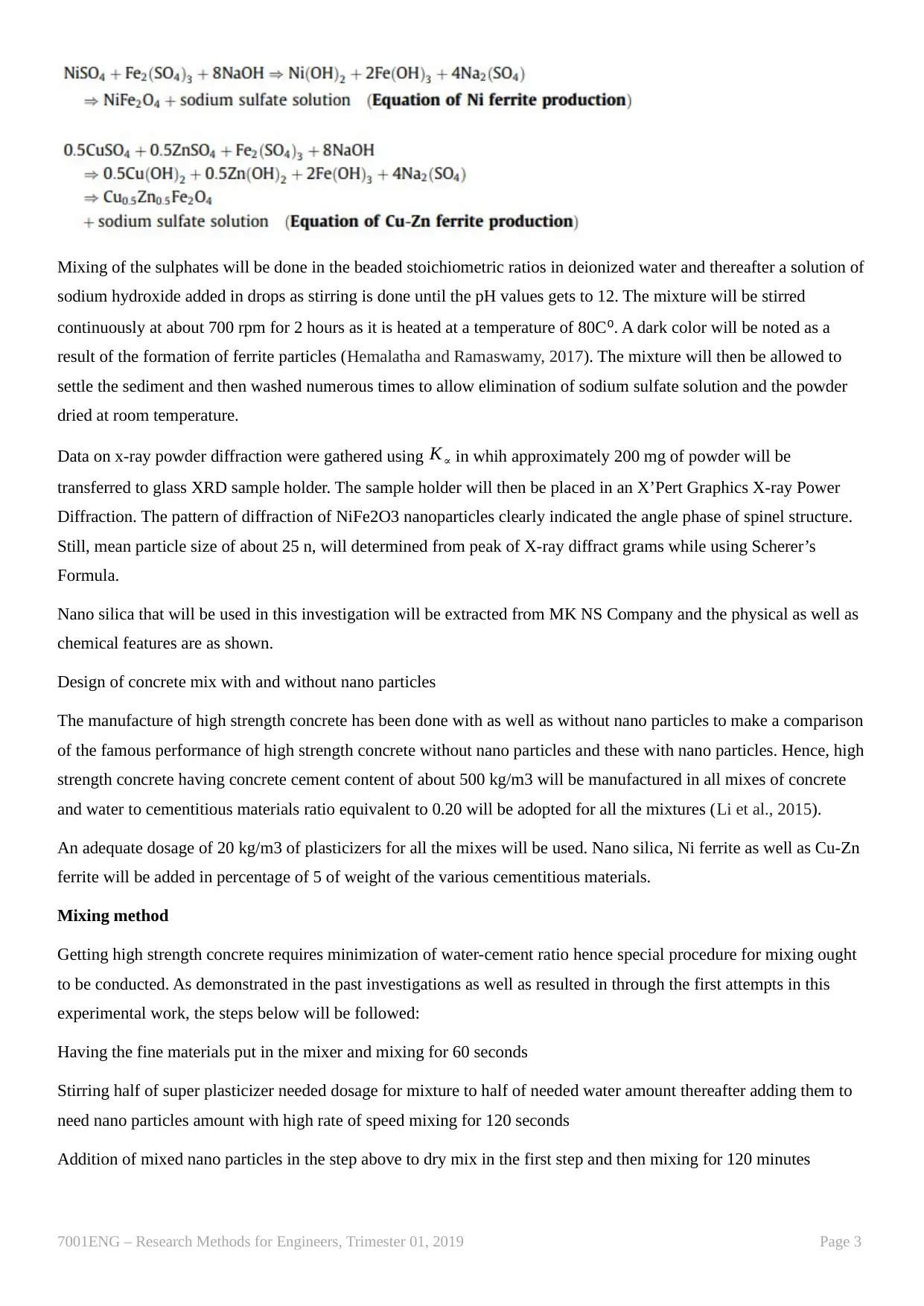
Mixing of the sulphates will be done in the beaded stoichiometric ratios in deionized water and thereafter a solution of
sodium hydroxide added in drops as stirring is done until the pH values gets to 12. The mixture will be stirred
continuously at about 700 rpm for 2 hours as it is heated at a temperature of 80C⁰. A dark color will be noted as a
result of the formation of ferrite particles (Hemalatha and Ramaswamy, 2017). The mixture will then be allowed to
settle the sediment and then washed numerous times to allow elimination of sodium sulfate solution and the powder
dried at room temperature.
Data on x-ray powder diffraction were gathered using K∝ in whih approximately 200 mg of powder will be
transferred to glass XRD sample holder. The sample holder will then be placed in an X’Pert Graphics X-ray Power
Diffraction. The pattern of diffraction of NiFe2O3 nanoparticles clearly indicated the angle phase of spinel structure.
Still, mean particle size of about 25 n, will determined from peak of X-ray diffract grams while using Scherer’s
Formula.
Nano silica that will be used in this investigation will be extracted from MK NS Company and the physical as well as
chemical features are as shown.
Design of concrete mix with and without nano particles
The manufacture of high strength concrete has been done with as well as without nano particles to make a comparison
of the famous performance of high strength concrete without nano particles and these with nano particles. Hence, high
strength concrete having concrete cement content of about 500 kg/m3 will be manufactured in all mixes of concrete
and water to cementitious materials ratio equivalent to 0.20 will be adopted for all the mixtures (Li et al., 2015).
An adequate dosage of 20 kg/m3 of plasticizers for all the mixes will be used. Nano silica, Ni ferrite as well as Cu-Zn
ferrite will be added in percentage of 5 of weight of the various cementitious materials.
Mixing method
Getting high strength concrete requires minimization of water-cement ratio hence special procedure for mixing ought
to be conducted. As demonstrated in the past investigations as well as resulted in through the first attempts in this
experimental work, the steps below will be followed:
Having the fine materials put in the mixer and mixing for 60 seconds
Stirring half of super plasticizer needed dosage for mixture to half of needed water amount thereafter adding them to
need nano particles amount with high rate of speed mixing for 120 seconds
Addition of mixed nano particles in the step above to dry mix in the first step and then mixing for 120 minutes
7001ENG – Research Methods for Engineers, Trimester 01, 2019 Page 3
sodium hydroxide added in drops as stirring is done until the pH values gets to 12. The mixture will be stirred
continuously at about 700 rpm for 2 hours as it is heated at a temperature of 80C⁰. A dark color will be noted as a
result of the formation of ferrite particles (Hemalatha and Ramaswamy, 2017). The mixture will then be allowed to
settle the sediment and then washed numerous times to allow elimination of sodium sulfate solution and the powder
dried at room temperature.
Data on x-ray powder diffraction were gathered using K∝ in whih approximately 200 mg of powder will be
transferred to glass XRD sample holder. The sample holder will then be placed in an X’Pert Graphics X-ray Power
Diffraction. The pattern of diffraction of NiFe2O3 nanoparticles clearly indicated the angle phase of spinel structure.
Still, mean particle size of about 25 n, will determined from peak of X-ray diffract grams while using Scherer’s
Formula.
Nano silica that will be used in this investigation will be extracted from MK NS Company and the physical as well as
chemical features are as shown.
Design of concrete mix with and without nano particles
The manufacture of high strength concrete has been done with as well as without nano particles to make a comparison
of the famous performance of high strength concrete without nano particles and these with nano particles. Hence, high
strength concrete having concrete cement content of about 500 kg/m3 will be manufactured in all mixes of concrete
and water to cementitious materials ratio equivalent to 0.20 will be adopted for all the mixtures (Li et al., 2015).
An adequate dosage of 20 kg/m3 of plasticizers for all the mixes will be used. Nano silica, Ni ferrite as well as Cu-Zn
ferrite will be added in percentage of 5 of weight of the various cementitious materials.
Mixing method
Getting high strength concrete requires minimization of water-cement ratio hence special procedure for mixing ought
to be conducted. As demonstrated in the past investigations as well as resulted in through the first attempts in this
experimental work, the steps below will be followed:
Having the fine materials put in the mixer and mixing for 60 seconds
Stirring half of super plasticizer needed dosage for mixture to half of needed water amount thereafter adding them to
need nano particles amount with high rate of speed mixing for 120 seconds
Addition of mixed nano particles in the step above to dry mix in the first step and then mixing for 120 minutes
7001ENG – Research Methods for Engineers, Trimester 01, 2019 Page 3
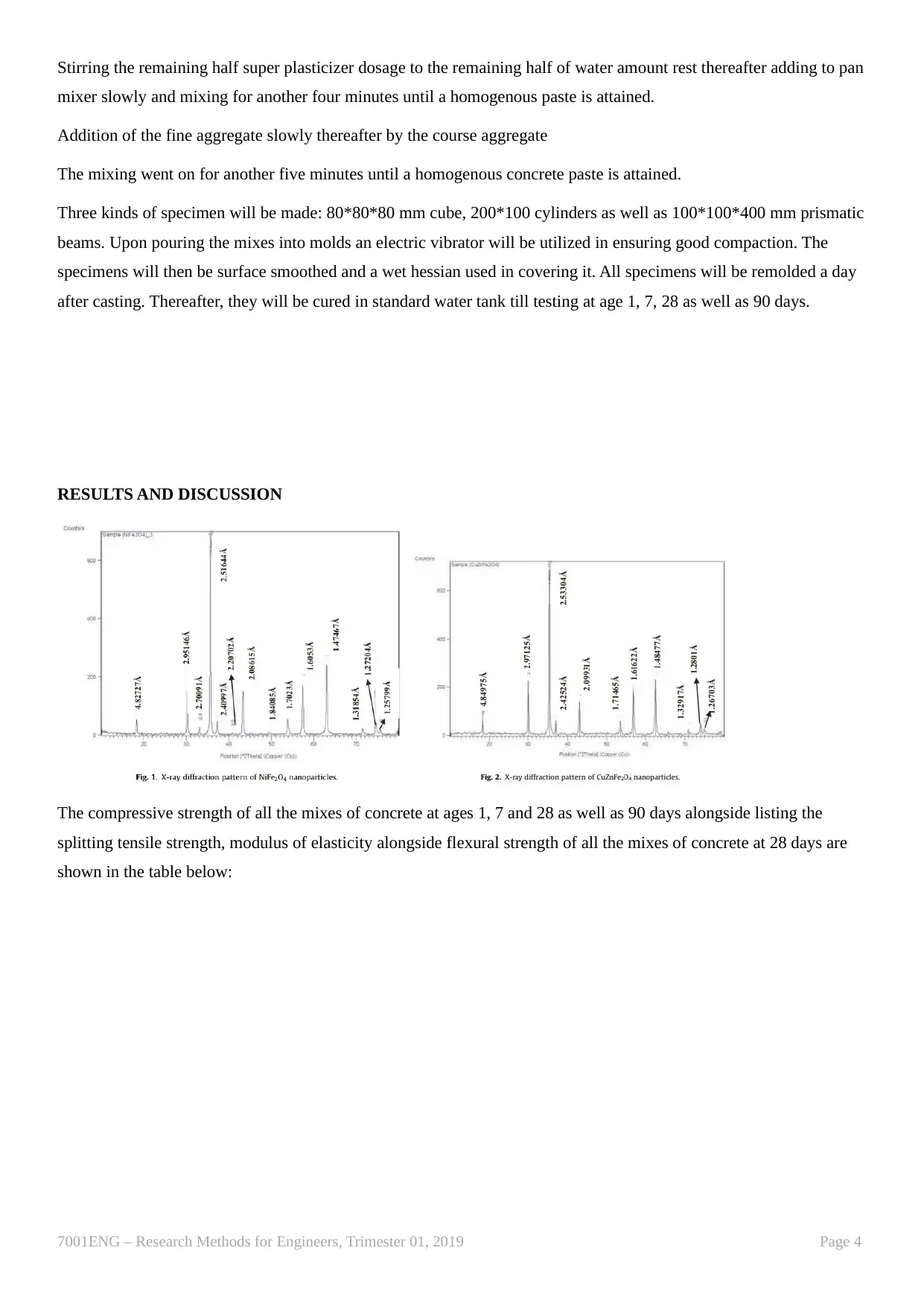
Stirring the remaining half super plasticizer dosage to the remaining half of water amount rest thereafter adding to pan
mixer slowly and mixing for another four minutes until a homogenous paste is attained.
Addition of the fine aggregate slowly thereafter by the course aggregate
The mixing went on for another five minutes until a homogenous concrete paste is attained.
Three kinds of specimen will be made: 80*80*80 mm cube, 200*100 cylinders as well as 100*100*400 mm prismatic
beams. Upon pouring the mixes into molds an electric vibrator will be utilized in ensuring good compaction. The
specimens will then be surface smoothed and a wet hessian used in covering it. All specimens will be remolded a day
after casting. Thereafter, they will be cured in standard water tank till testing at age 1, 7, 28 as well as 90 days.
RESULTS AND DISCUSSION
The compressive strength of all the mixes of concrete at ages 1, 7 and 28 as well as 90 days alongside listing the
splitting tensile strength, modulus of elasticity alongside flexural strength of all the mixes of concrete at 28 days are
shown in the table below:
7001ENG – Research Methods for Engineers, Trimester 01, 2019 Page 4
mixer slowly and mixing for another four minutes until a homogenous paste is attained.
Addition of the fine aggregate slowly thereafter by the course aggregate
The mixing went on for another five minutes until a homogenous concrete paste is attained.
Three kinds of specimen will be made: 80*80*80 mm cube, 200*100 cylinders as well as 100*100*400 mm prismatic
beams. Upon pouring the mixes into molds an electric vibrator will be utilized in ensuring good compaction. The
specimens will then be surface smoothed and a wet hessian used in covering it. All specimens will be remolded a day
after casting. Thereafter, they will be cured in standard water tank till testing at age 1, 7, 28 as well as 90 days.
RESULTS AND DISCUSSION
The compressive strength of all the mixes of concrete at ages 1, 7 and 28 as well as 90 days alongside listing the
splitting tensile strength, modulus of elasticity alongside flexural strength of all the mixes of concrete at 28 days are
shown in the table below:
7001ENG – Research Methods for Engineers, Trimester 01, 2019 Page 4
Secure Best Marks with AI Grader
Need help grading? Try our AI Grader for instant feedback on your assignments.
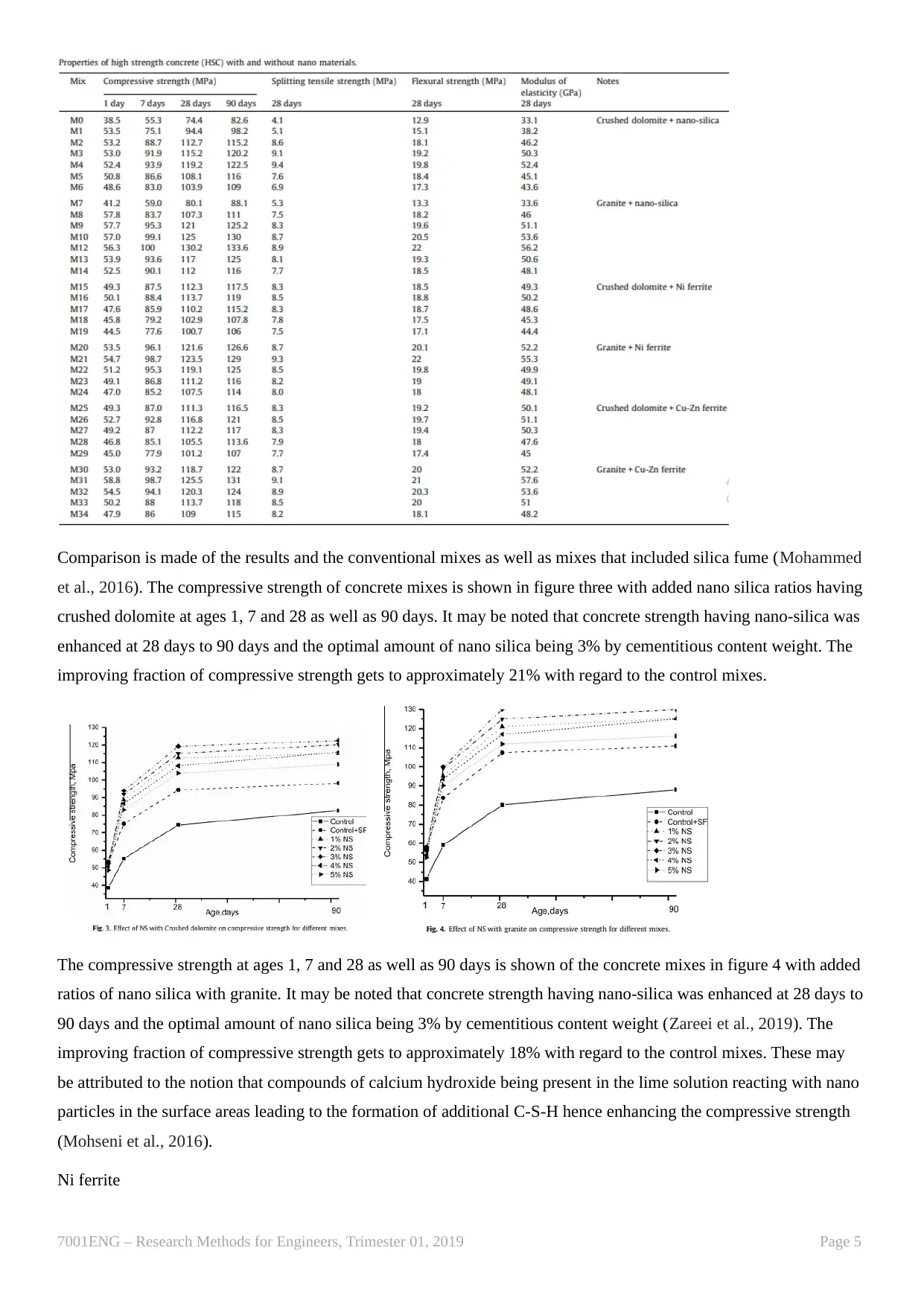
Comparison is made of the results and the conventional mixes as well as mixes that included silica fume (Mohammed
et al., 2016). The compressive strength of concrete mixes is shown in figure three with added nano silica ratios having
crushed dolomite at ages 1, 7 and 28 as well as 90 days. It may be noted that concrete strength having nano-silica was
enhanced at 28 days to 90 days and the optimal amount of nano silica being 3% by cementitious content weight. The
improving fraction of compressive strength gets to approximately 21% with regard to the control mixes.
The compressive strength at ages 1, 7 and 28 as well as 90 days is shown of the concrete mixes in figure 4 with added
ratios of nano silica with granite. It may be noted that concrete strength having nano-silica was enhanced at 28 days to
90 days and the optimal amount of nano silica being 3% by cementitious content weight (Zareei et al., 2019). The
improving fraction of compressive strength gets to approximately 18% with regard to the control mixes. These may
be attributed to the notion that compounds of calcium hydroxide being present in the lime solution reacting with nano
particles in the surface areas leading to the formation of additional C-S-H hence enhancing the compressive strength
(Mohseni et al., 2016).
Ni ferrite
7001ENG – Research Methods for Engineers, Trimester 01, 2019 Page 5
et al., 2016). The compressive strength of concrete mixes is shown in figure three with added nano silica ratios having
crushed dolomite at ages 1, 7 and 28 as well as 90 days. It may be noted that concrete strength having nano-silica was
enhanced at 28 days to 90 days and the optimal amount of nano silica being 3% by cementitious content weight. The
improving fraction of compressive strength gets to approximately 21% with regard to the control mixes.
The compressive strength at ages 1, 7 and 28 as well as 90 days is shown of the concrete mixes in figure 4 with added
ratios of nano silica with granite. It may be noted that concrete strength having nano-silica was enhanced at 28 days to
90 days and the optimal amount of nano silica being 3% by cementitious content weight (Zareei et al., 2019). The
improving fraction of compressive strength gets to approximately 18% with regard to the control mixes. These may
be attributed to the notion that compounds of calcium hydroxide being present in the lime solution reacting with nano
particles in the surface areas leading to the formation of additional C-S-H hence enhancing the compressive strength
(Mohseni et al., 2016).
Ni ferrite
7001ENG – Research Methods for Engineers, Trimester 01, 2019 Page 5
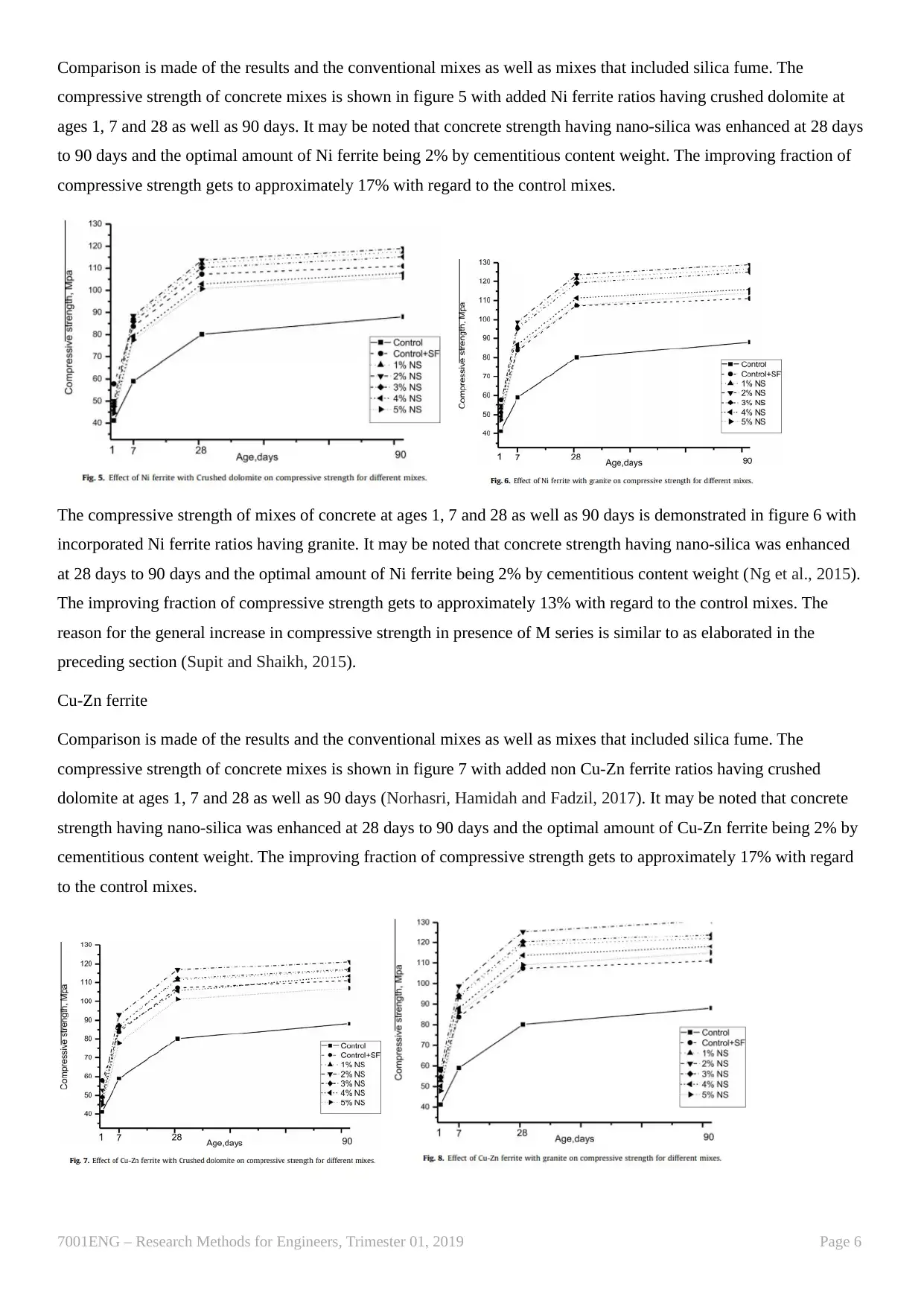
Comparison is made of the results and the conventional mixes as well as mixes that included silica fume. The
compressive strength of concrete mixes is shown in figure 5 with added Ni ferrite ratios having crushed dolomite at
ages 1, 7 and 28 as well as 90 days. It may be noted that concrete strength having nano-silica was enhanced at 28 days
to 90 days and the optimal amount of Ni ferrite being 2% by cementitious content weight. The improving fraction of
compressive strength gets to approximately 17% with regard to the control mixes.
The compressive strength of mixes of concrete at ages 1, 7 and 28 as well as 90 days is demonstrated in figure 6 with
incorporated Ni ferrite ratios having granite. It may be noted that concrete strength having nano-silica was enhanced
at 28 days to 90 days and the optimal amount of Ni ferrite being 2% by cementitious content weight (Ng et al., 2015).
The improving fraction of compressive strength gets to approximately 13% with regard to the control mixes. The
reason for the general increase in compressive strength in presence of M series is similar to as elaborated in the
preceding section (Supit and Shaikh, 2015).
Cu-Zn ferrite
Comparison is made of the results and the conventional mixes as well as mixes that included silica fume. The
compressive strength of concrete mixes is shown in figure 7 with added non Cu-Zn ferrite ratios having crushed
dolomite at ages 1, 7 and 28 as well as 90 days (Norhasri, Hamidah and Fadzil, 2017). It may be noted that concrete
strength having nano-silica was enhanced at 28 days to 90 days and the optimal amount of Cu-Zn ferrite being 2% by
cementitious content weight. The improving fraction of compressive strength gets to approximately 17% with regard
to the control mixes.
7001ENG – Research Methods for Engineers, Trimester 01, 2019 Page 6
compressive strength of concrete mixes is shown in figure 5 with added Ni ferrite ratios having crushed dolomite at
ages 1, 7 and 28 as well as 90 days. It may be noted that concrete strength having nano-silica was enhanced at 28 days
to 90 days and the optimal amount of Ni ferrite being 2% by cementitious content weight. The improving fraction of
compressive strength gets to approximately 17% with regard to the control mixes.
The compressive strength of mixes of concrete at ages 1, 7 and 28 as well as 90 days is demonstrated in figure 6 with
incorporated Ni ferrite ratios having granite. It may be noted that concrete strength having nano-silica was enhanced
at 28 days to 90 days and the optimal amount of Ni ferrite being 2% by cementitious content weight (Ng et al., 2015).
The improving fraction of compressive strength gets to approximately 13% with regard to the control mixes. The
reason for the general increase in compressive strength in presence of M series is similar to as elaborated in the
preceding section (Supit and Shaikh, 2015).
Cu-Zn ferrite
Comparison is made of the results and the conventional mixes as well as mixes that included silica fume. The
compressive strength of concrete mixes is shown in figure 7 with added non Cu-Zn ferrite ratios having crushed
dolomite at ages 1, 7 and 28 as well as 90 days (Norhasri, Hamidah and Fadzil, 2017). It may be noted that concrete
strength having nano-silica was enhanced at 28 days to 90 days and the optimal amount of Cu-Zn ferrite being 2% by
cementitious content weight. The improving fraction of compressive strength gets to approximately 17% with regard
to the control mixes.
7001ENG – Research Methods for Engineers, Trimester 01, 2019 Page 6
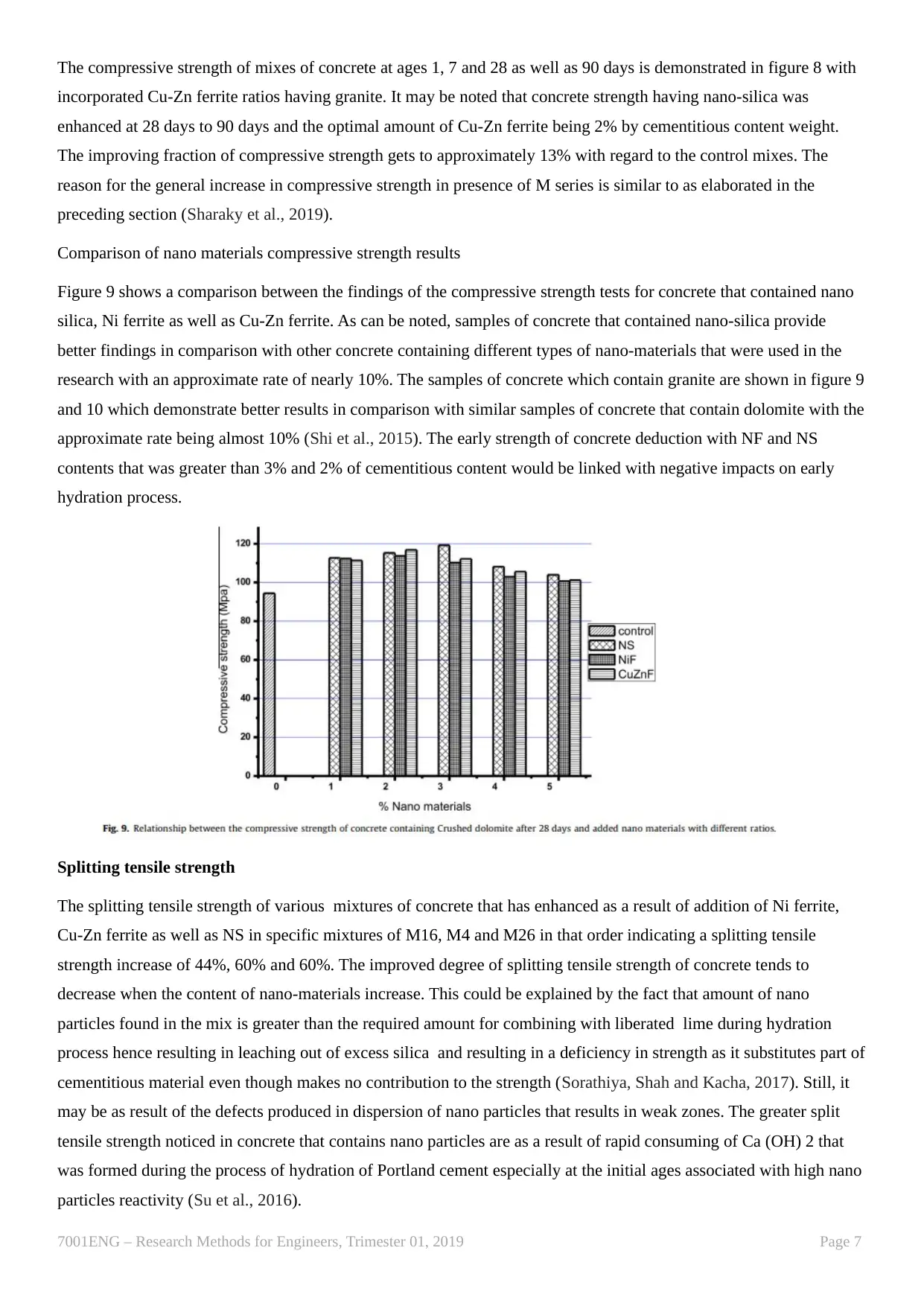
The compressive strength of mixes of concrete at ages 1, 7 and 28 as well as 90 days is demonstrated in figure 8 with
incorporated Cu-Zn ferrite ratios having granite. It may be noted that concrete strength having nano-silica was
enhanced at 28 days to 90 days and the optimal amount of Cu-Zn ferrite being 2% by cementitious content weight.
The improving fraction of compressive strength gets to approximately 13% with regard to the control mixes. The
reason for the general increase in compressive strength in presence of M series is similar to as elaborated in the
preceding section (Sharaky et al., 2019).
Comparison of nano materials compressive strength results
Figure 9 shows a comparison between the findings of the compressive strength tests for concrete that contained nano
silica, Ni ferrite as well as Cu-Zn ferrite. As can be noted, samples of concrete that contained nano-silica provide
better findings in comparison with other concrete containing different types of nano-materials that were used in the
research with an approximate rate of nearly 10%. The samples of concrete which contain granite are shown in figure 9
and 10 which demonstrate better results in comparison with similar samples of concrete that contain dolomite with the
approximate rate being almost 10% (Shi et al., 2015). The early strength of concrete deduction with NF and NS
contents that was greater than 3% and 2% of cementitious content would be linked with negative impacts on early
hydration process.
Splitting tensile strength
The splitting tensile strength of various mixtures of concrete that has enhanced as a result of addition of Ni ferrite,
Cu-Zn ferrite as well as NS in specific mixtures of M16, M4 and M26 in that order indicating a splitting tensile
strength increase of 44%, 60% and 60%. The improved degree of splitting tensile strength of concrete tends to
decrease when the content of nano-materials increase. This could be explained by the fact that amount of nano
particles found in the mix is greater than the required amount for combining with liberated lime during hydration
process hence resulting in leaching out of excess silica and resulting in a deficiency in strength as it substitutes part of
cementitious material even though makes no contribution to the strength (Sorathiya, Shah and Kacha, 2017). Still, it
may be as result of the defects produced in dispersion of nano particles that results in weak zones. The greater split
tensile strength noticed in concrete that contains nano particles are as a result of rapid consuming of Ca (OH) 2 that
was formed during the process of hydration of Portland cement especially at the initial ages associated with high nano
particles reactivity (Su et al., 2016).
7001ENG – Research Methods for Engineers, Trimester 01, 2019 Page 7
incorporated Cu-Zn ferrite ratios having granite. It may be noted that concrete strength having nano-silica was
enhanced at 28 days to 90 days and the optimal amount of Cu-Zn ferrite being 2% by cementitious content weight.
The improving fraction of compressive strength gets to approximately 13% with regard to the control mixes. The
reason for the general increase in compressive strength in presence of M series is similar to as elaborated in the
preceding section (Sharaky et al., 2019).
Comparison of nano materials compressive strength results
Figure 9 shows a comparison between the findings of the compressive strength tests for concrete that contained nano
silica, Ni ferrite as well as Cu-Zn ferrite. As can be noted, samples of concrete that contained nano-silica provide
better findings in comparison with other concrete containing different types of nano-materials that were used in the
research with an approximate rate of nearly 10%. The samples of concrete which contain granite are shown in figure 9
and 10 which demonstrate better results in comparison with similar samples of concrete that contain dolomite with the
approximate rate being almost 10% (Shi et al., 2015). The early strength of concrete deduction with NF and NS
contents that was greater than 3% and 2% of cementitious content would be linked with negative impacts on early
hydration process.
Splitting tensile strength
The splitting tensile strength of various mixtures of concrete that has enhanced as a result of addition of Ni ferrite,
Cu-Zn ferrite as well as NS in specific mixtures of M16, M4 and M26 in that order indicating a splitting tensile
strength increase of 44%, 60% and 60%. The improved degree of splitting tensile strength of concrete tends to
decrease when the content of nano-materials increase. This could be explained by the fact that amount of nano
particles found in the mix is greater than the required amount for combining with liberated lime during hydration
process hence resulting in leaching out of excess silica and resulting in a deficiency in strength as it substitutes part of
cementitious material even though makes no contribution to the strength (Sorathiya, Shah and Kacha, 2017). Still, it
may be as result of the defects produced in dispersion of nano particles that results in weak zones. The greater split
tensile strength noticed in concrete that contains nano particles are as a result of rapid consuming of Ca (OH) 2 that
was formed during the process of hydration of Portland cement especially at the initial ages associated with high nano
particles reactivity (Su et al., 2016).
7001ENG – Research Methods for Engineers, Trimester 01, 2019 Page 7
Paraphrase This Document
Need a fresh take? Get an instant paraphrase of this document with our AI Paraphraser
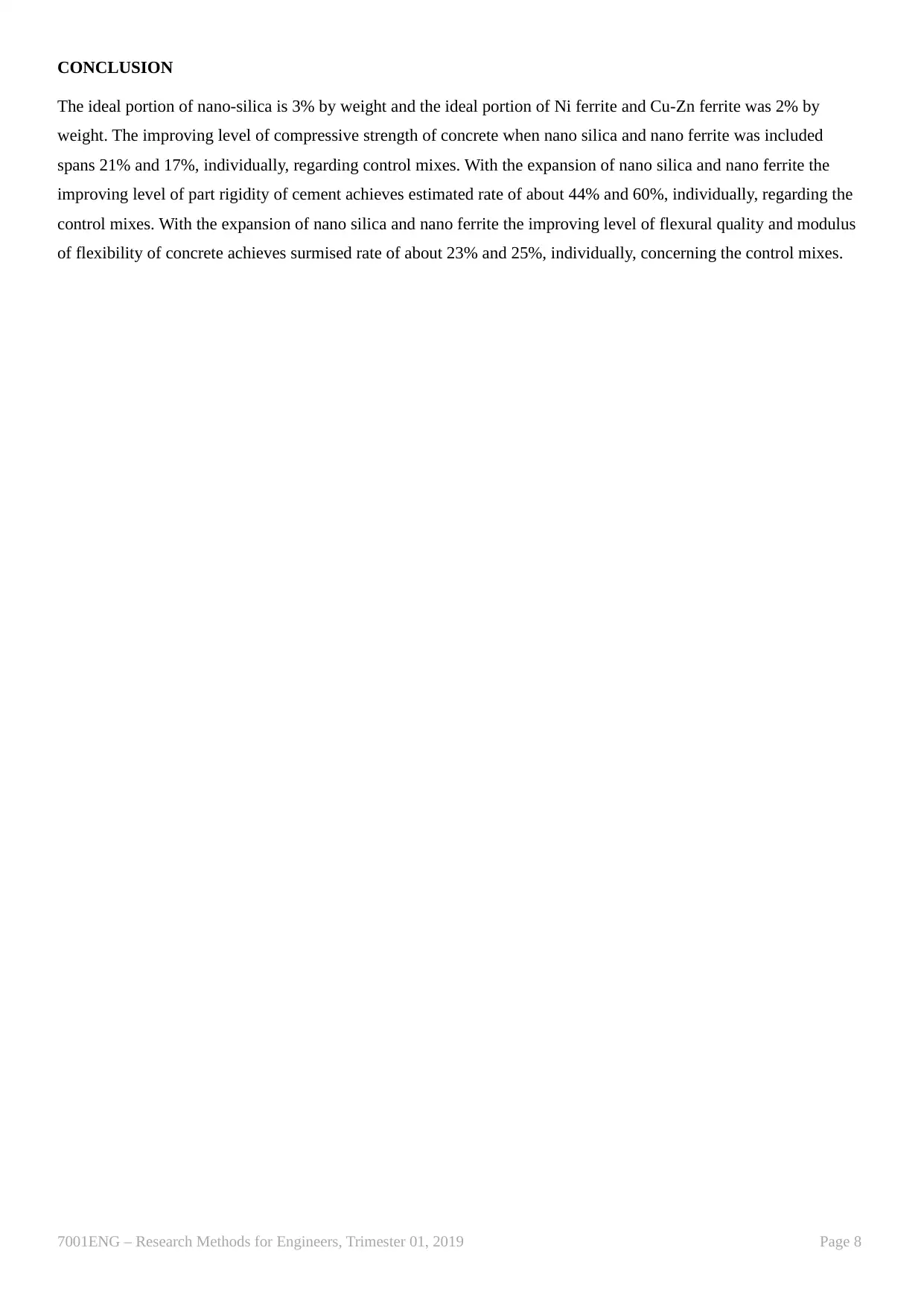
CONCLUSION
The ideal portion of nano-silica is 3% by weight and the ideal portion of Ni ferrite and Cu-Zn ferrite was 2% by
weight. The improving level of compressive strength of concrete when nano silica and nano ferrite was included
spans 21% and 17%, individually, regarding control mixes. With the expansion of nano silica and nano ferrite the
improving level of part rigidity of cement achieves estimated rate of about 44% and 60%, individually, regarding the
control mixes. With the expansion of nano silica and nano ferrite the improving level of flexural quality and modulus
of flexibility of concrete achieves surmised rate of about 23% and 25%, individually, concerning the control mixes.
7001ENG – Research Methods for Engineers, Trimester 01, 2019 Page 8
The ideal portion of nano-silica is 3% by weight and the ideal portion of Ni ferrite and Cu-Zn ferrite was 2% by
weight. The improving level of compressive strength of concrete when nano silica and nano ferrite was included
spans 21% and 17%, individually, regarding control mixes. With the expansion of nano silica and nano ferrite the
improving level of part rigidity of cement achieves estimated rate of about 44% and 60%, individually, regarding the
control mixes. With the expansion of nano silica and nano ferrite the improving level of flexural quality and modulus
of flexibility of concrete achieves surmised rate of about 23% and 25%, individually, concerning the control mixes.
7001ENG – Research Methods for Engineers, Trimester 01, 2019 Page 8
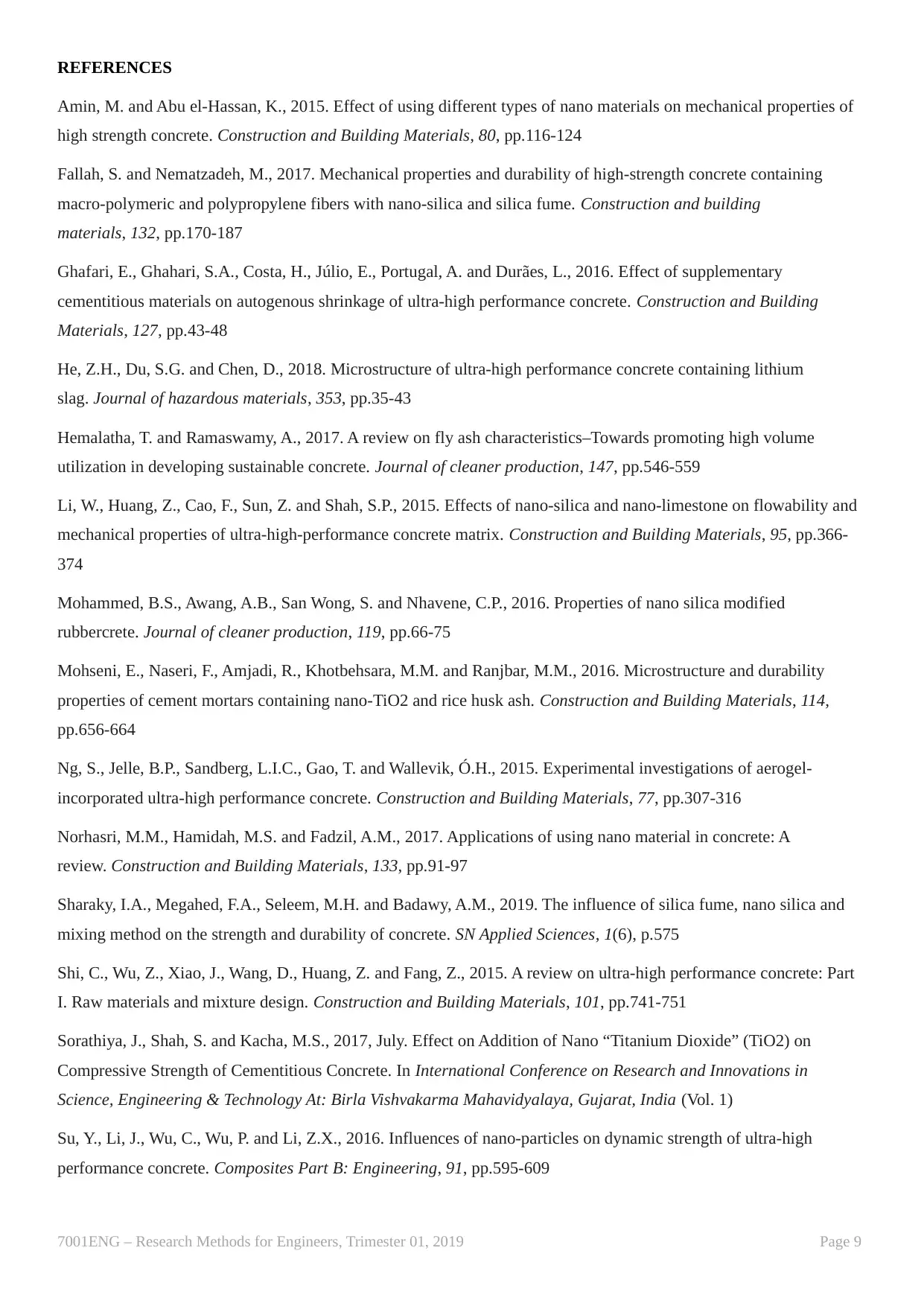
REFERENCES
Amin, M. and Abu el-Hassan, K., 2015. Effect of using different types of nano materials on mechanical properties of
high strength concrete. Construction and Building Materials, 80, pp.116-124
Fallah, S. and Nematzadeh, M., 2017. Mechanical properties and durability of high-strength concrete containing
macro-polymeric and polypropylene fibers with nano-silica and silica fume. Construction and building
materials, 132, pp.170-187
Ghafari, E., Ghahari, S.A., Costa, H., Júlio, E., Portugal, A. and Durães, L., 2016. Effect of supplementary
cementitious materials on autogenous shrinkage of ultra-high performance concrete. Construction and Building
Materials, 127, pp.43-48
He, Z.H., Du, S.G. and Chen, D., 2018. Microstructure of ultra-high performance concrete containing lithium
slag. Journal of hazardous materials, 353, pp.35-43
Hemalatha, T. and Ramaswamy, A., 2017. A review on fly ash characteristics–Towards promoting high volume
utilization in developing sustainable concrete. Journal of cleaner production, 147, pp.546-559
Li, W., Huang, Z., Cao, F., Sun, Z. and Shah, S.P., 2015. Effects of nano-silica and nano-limestone on flowability and
mechanical properties of ultra-high-performance concrete matrix. Construction and Building Materials, 95, pp.366-
374
Mohammed, B.S., Awang, A.B., San Wong, S. and Nhavene, C.P., 2016. Properties of nano silica modified
rubbercrete. Journal of cleaner production, 119, pp.66-75
Mohseni, E., Naseri, F., Amjadi, R., Khotbehsara, M.M. and Ranjbar, M.M., 2016. Microstructure and durability
properties of cement mortars containing nano-TiO2 and rice husk ash. Construction and Building Materials, 114,
pp.656-664
Ng, S., Jelle, B.P., Sandberg, L.I.C., Gao, T. and Wallevik, Ó.H., 2015. Experimental investigations of aerogel-
incorporated ultra-high performance concrete. Construction and Building Materials, 77, pp.307-316
Norhasri, M.M., Hamidah, M.S. and Fadzil, A.M., 2017. Applications of using nano material in concrete: A
review. Construction and Building Materials, 133, pp.91-97
Sharaky, I.A., Megahed, F.A., Seleem, M.H. and Badawy, A.M., 2019. The influence of silica fume, nano silica and
mixing method on the strength and durability of concrete. SN Applied Sciences, 1(6), p.575
Shi, C., Wu, Z., Xiao, J., Wang, D., Huang, Z. and Fang, Z., 2015. A review on ultra-high performance concrete: Part
I. Raw materials and mixture design. Construction and Building Materials, 101, pp.741-751
Sorathiya, J., Shah, S. and Kacha, M.S., 2017, July. Effect on Addition of Nano “Titanium Dioxide” (TiO2) on
Compressive Strength of Cementitious Concrete. In International Conference on Research and Innovations in
Science, Engineering & Technology At: Birla Vishvakarma Mahavidyalaya, Gujarat, India (Vol. 1)
Su, Y., Li, J., Wu, C., Wu, P. and Li, Z.X., 2016. Influences of nano-particles on dynamic strength of ultra-high
performance concrete. Composites Part B: Engineering, 91, pp.595-609
7001ENG – Research Methods for Engineers, Trimester 01, 2019 Page 9
Amin, M. and Abu el-Hassan, K., 2015. Effect of using different types of nano materials on mechanical properties of
high strength concrete. Construction and Building Materials, 80, pp.116-124
Fallah, S. and Nematzadeh, M., 2017. Mechanical properties and durability of high-strength concrete containing
macro-polymeric and polypropylene fibers with nano-silica and silica fume. Construction and building
materials, 132, pp.170-187
Ghafari, E., Ghahari, S.A., Costa, H., Júlio, E., Portugal, A. and Durães, L., 2016. Effect of supplementary
cementitious materials on autogenous shrinkage of ultra-high performance concrete. Construction and Building
Materials, 127, pp.43-48
He, Z.H., Du, S.G. and Chen, D., 2018. Microstructure of ultra-high performance concrete containing lithium
slag. Journal of hazardous materials, 353, pp.35-43
Hemalatha, T. and Ramaswamy, A., 2017. A review on fly ash characteristics–Towards promoting high volume
utilization in developing sustainable concrete. Journal of cleaner production, 147, pp.546-559
Li, W., Huang, Z., Cao, F., Sun, Z. and Shah, S.P., 2015. Effects of nano-silica and nano-limestone on flowability and
mechanical properties of ultra-high-performance concrete matrix. Construction and Building Materials, 95, pp.366-
374
Mohammed, B.S., Awang, A.B., San Wong, S. and Nhavene, C.P., 2016. Properties of nano silica modified
rubbercrete. Journal of cleaner production, 119, pp.66-75
Mohseni, E., Naseri, F., Amjadi, R., Khotbehsara, M.M. and Ranjbar, M.M., 2016. Microstructure and durability
properties of cement mortars containing nano-TiO2 and rice husk ash. Construction and Building Materials, 114,
pp.656-664
Ng, S., Jelle, B.P., Sandberg, L.I.C., Gao, T. and Wallevik, Ó.H., 2015. Experimental investigations of aerogel-
incorporated ultra-high performance concrete. Construction and Building Materials, 77, pp.307-316
Norhasri, M.M., Hamidah, M.S. and Fadzil, A.M., 2017. Applications of using nano material in concrete: A
review. Construction and Building Materials, 133, pp.91-97
Sharaky, I.A., Megahed, F.A., Seleem, M.H. and Badawy, A.M., 2019. The influence of silica fume, nano silica and
mixing method on the strength and durability of concrete. SN Applied Sciences, 1(6), p.575
Shi, C., Wu, Z., Xiao, J., Wang, D., Huang, Z. and Fang, Z., 2015. A review on ultra-high performance concrete: Part
I. Raw materials and mixture design. Construction and Building Materials, 101, pp.741-751
Sorathiya, J., Shah, S. and Kacha, M.S., 2017, July. Effect on Addition of Nano “Titanium Dioxide” (TiO2) on
Compressive Strength of Cementitious Concrete. In International Conference on Research and Innovations in
Science, Engineering & Technology At: Birla Vishvakarma Mahavidyalaya, Gujarat, India (Vol. 1)
Su, Y., Li, J., Wu, C., Wu, P. and Li, Z.X., 2016. Influences of nano-particles on dynamic strength of ultra-high
performance concrete. Composites Part B: Engineering, 91, pp.595-609
7001ENG – Research Methods for Engineers, Trimester 01, 2019 Page 9
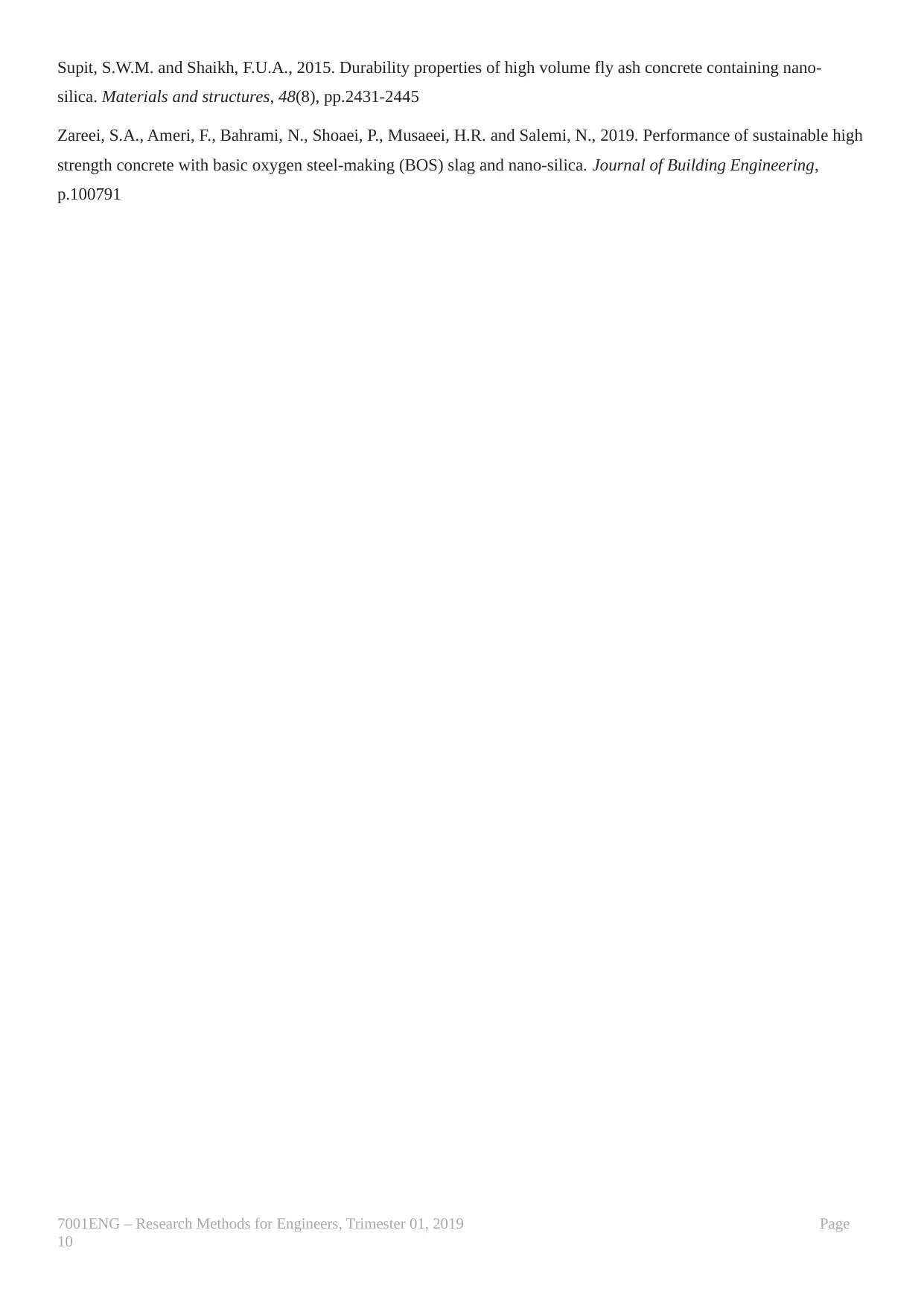
Supit, S.W.M. and Shaikh, F.U.A., 2015. Durability properties of high volume fly ash concrete containing nano-
silica. Materials and structures, 48(8), pp.2431-2445
Zareei, S.A., Ameri, F., Bahrami, N., Shoaei, P., Musaeei, H.R. and Salemi, N., 2019. Performance of sustainable high
strength concrete with basic oxygen steel-making (BOS) slag and nano-silica. Journal of Building Engineering,
p.100791
7001ENG – Research Methods for Engineers, Trimester 01, 2019 Page
10
silica. Materials and structures, 48(8), pp.2431-2445
Zareei, S.A., Ameri, F., Bahrami, N., Shoaei, P., Musaeei, H.R. and Salemi, N., 2019. Performance of sustainable high
strength concrete with basic oxygen steel-making (BOS) slag and nano-silica. Journal of Building Engineering,
p.100791
7001ENG – Research Methods for Engineers, Trimester 01, 2019 Page
10
1 out of 10
Your All-in-One AI-Powered Toolkit for Academic Success.
+13062052269
info@desklib.com
Available 24*7 on WhatsApp / Email
![[object Object]](/_next/static/media/star-bottom.7253800d.svg)
Unlock your academic potential
© 2024 | Zucol Services PVT LTD | All rights reserved.

